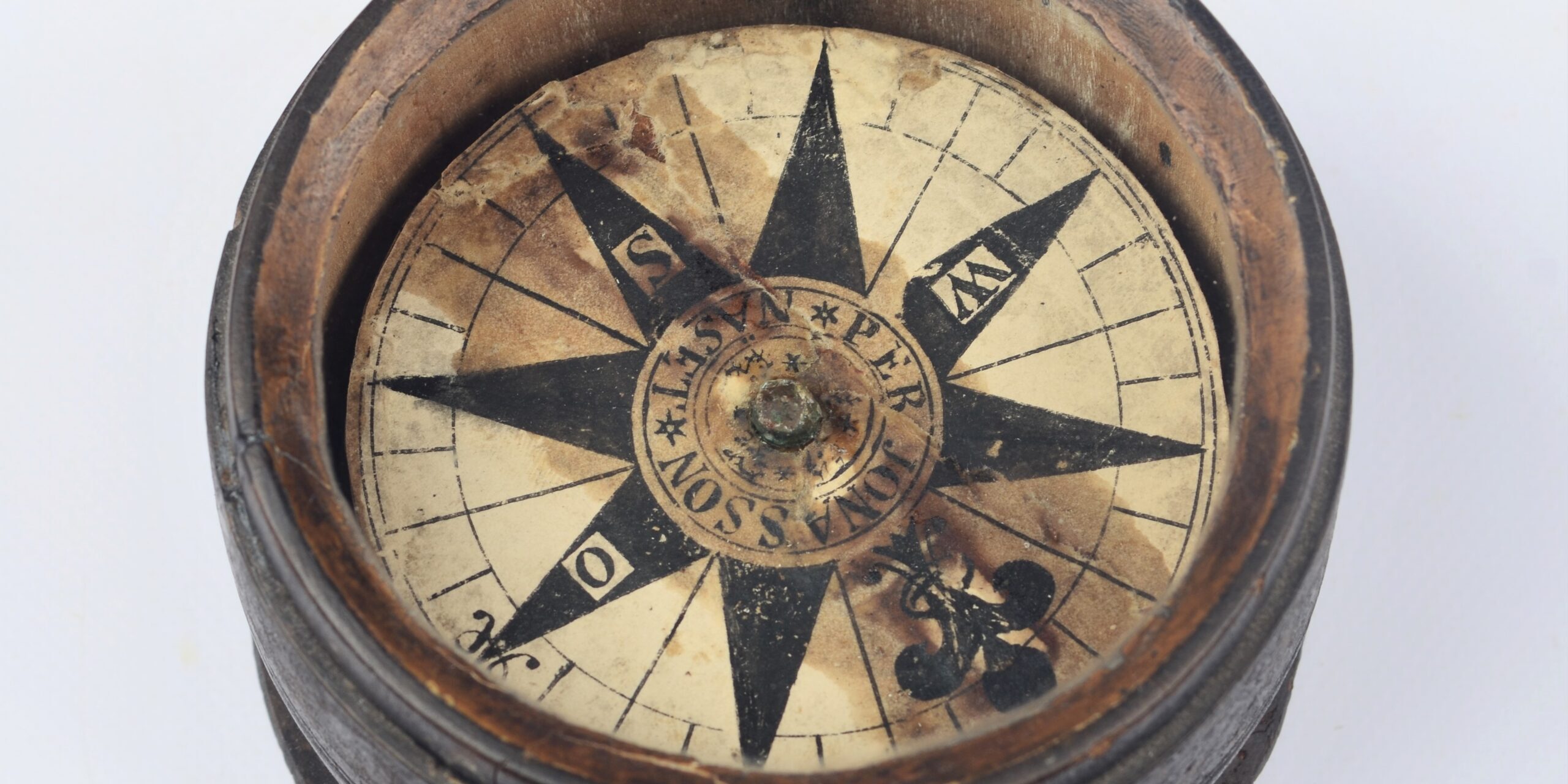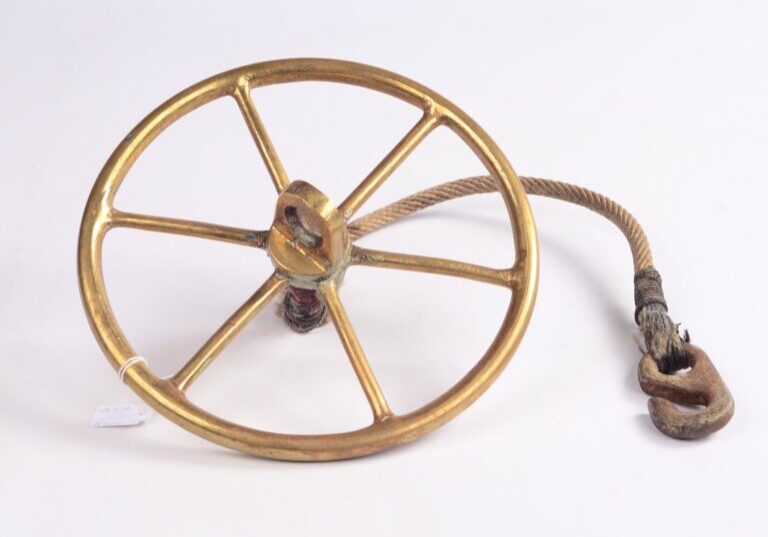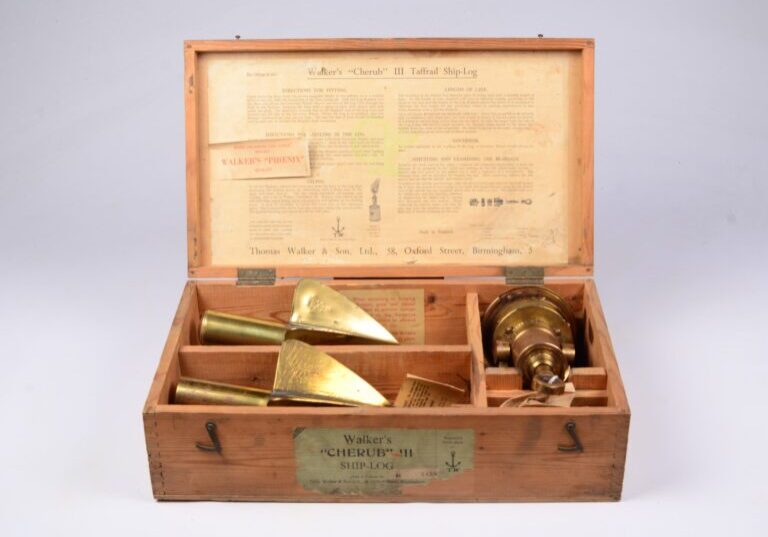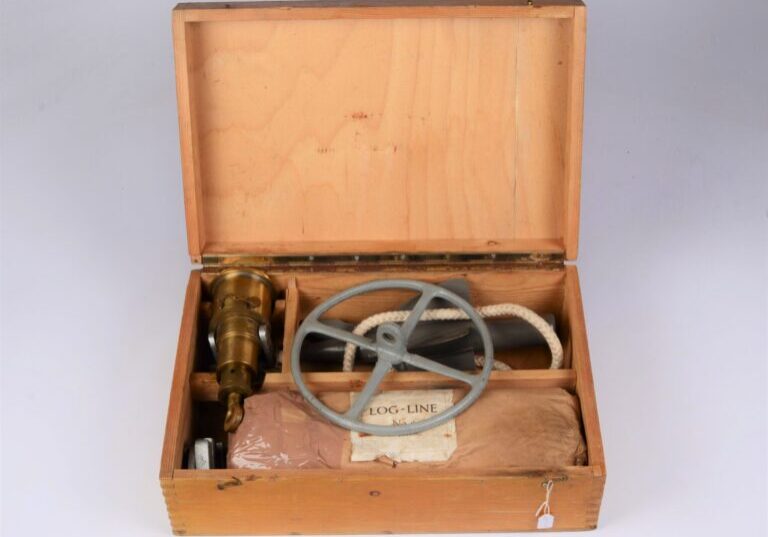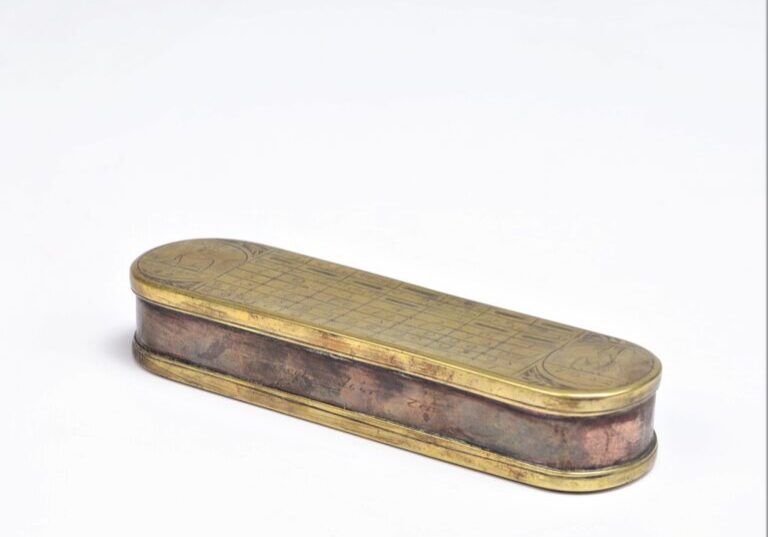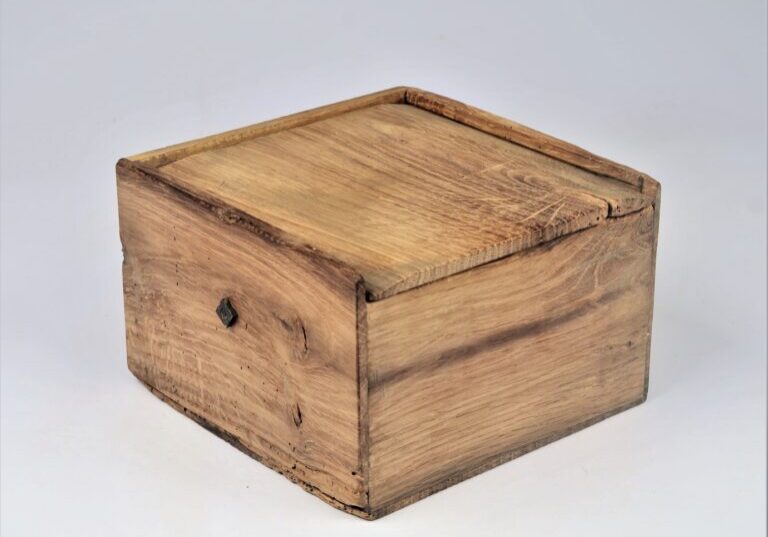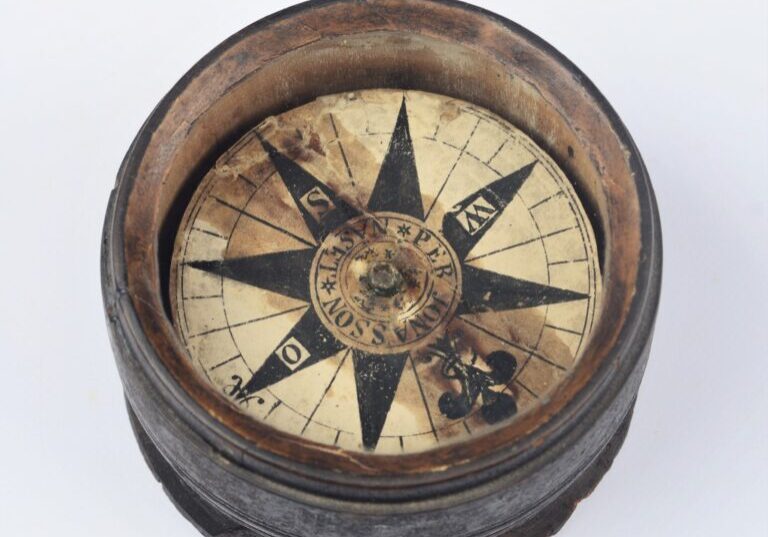Nautical instruments
This part of the collection includes mainly navigational instruments from the early sailing period, the time when ships were made of wood and men were made of steel.
Dutch seaman’s tobacco box of Pieter Holm, also known as the Dutchman’s Log, with a perpetual calendar on the top of the lid and a ship’s speed table on the bottom.
In a publication of 1748 Holm claims to have devised this table in 1729. The top of the lid is further adorned with simple vignettes portraying Julius Caesar and Pope Gregory XIII, who respectively in 45 BC and AD 1582 introduced the Julian calendar and the Gregorian calendar. The bottom carries a simple vignette of a person with a globe and a pair of dividers with the year 1497 who is tentatively identified as Amerigo Vespucci. On the bottom a short tekst in old Dutch, den eeuwig durenden almanack (the perpetual almanac). And on the frontside, Regt door Zee (Sail a Straight Course).
It’s an original box of 1729, see the lid bottom right.
Catalogue: NM.6-25
Date: 1729
HWL case: 3×15,5×4,7 cm
Signed: not signed
Origin: Netherlands
Condition: perfect condition with small signs of use
Signal flags according to the International Radiotelegraph Conference in Washington in 1930.
During WWII, the international signal book from 1897 was found not to work properly between ships of different nationalities. It was therefore decided to thoroughly revise this book.
The spoked fly wheel is introduced in 1878 by W. Waring. Subsequently applied in large quantities by Walkers and others. This early hand-made brass item is possible made by Waring.
Catalogue: NM.6-18
Date: ca. 1878
D: 22.5 cm
Signed: not signed
Origin: poss. England
Condition: perfect with small signs of use
A finely made ship’s log to measure the distance covered through the water within a certain time. Distance divided bij the time in hours, gives the speed in knots through the water.
A nice and complete Mark III in case with two spare windows, two rotators, hook and gimbal foot. Three dials on ennamel face, the larger registers up to 100 miles, the smaller two register up tot ten and 1000 mile. Two four bladed rotators stamped with anchor motif and initials TW.
The production of the Mark III commenced in 1930 and ceased in 1994. Details and serialnumber suggest a manufacturingdate circa 1940.
Catalogue: NM.6-17
Date: ca. 1940
L log: 24 cm
Diameter log: 11.7 cm
Log signed: WALKER’S CHERUB Mark III, serialnumber AG7722
Origin: England
Condition: good and complete
A finely made and unused ship’s log to measure the distance covered through the water within a certain time. Distance divided bij the time in hours, gives the speed in knots through the water.
Nice and complete log with rotator, two gimbal feet and line in case. Two dials on ennamel face, the larger registers up to 100 miles, the smaller one up tot 10 miles. The log does not appear to have been used.
Catalogue: NM.6-16
Date: ca. 1950
L log: 24.5 cm
Diameter log: 9 cm
Log signed: Cassens & Plath Logge
Origin: Germany
Condition: unused, good and complete

Dutch seaman’s tobacco box of Pieter Holm, also known as the Dutchman’s Log, with a perpetual calendar on the top of the lid and a ship’s speed table on the bottom.
In a publication of 1748 Holm claims to have devised this table in 1729. The top of the lid is further adorned with simple vignettes portraying Julius Caesar and Pope Gregory XIII, who respectively in 45 BC and AD 1582 introduced the Julian calendar and the Gregorian calendar. The bottom carries a simple vignette of a person with a globe and a pair of dividers with the year 1497 who is tentatively identified as Amerigo Vespucci. On the bottom a short Dutch text, geen kunst maar rijk, dan kan men verlieze, daarom is kunst van rijkdom te kiesen. (no art but rich, then one can lose, therefore art of riches to choose). And on the frontside, Regt door Zee (Sail a Straight Course).
The box is of 1751, see the lid bottom right.
Catalogue: NM.6-15
Date: 1751
HWL case: 3x17x4,7 cm
Signed: not signed
Origin: Netherlands
Condition: perfect with small signs of use
A finely made ship’s log to measure the distance covered through the water within a certain time. Distance divided bij the time in hours, gives the speed in knots through the water.
Mark III in case with two spare windows, two rotators, hook and gimbal foot. Three dials on ennamel face, the larger registers up to 100 miles, the smaller two register up tot ten and 1000 mile. Two four bladed rotators stamped with anchor motif and initials TW.
The production of the Mark III commenced in 1930 and ceased in 1994. Details and serialnumber suggest a manufacturingdate circa 1940.
Catalogue: NM.6-14
Date: ca. 1940
L log: 24 cm
Diameter log: 11.7 cm
Log signed: WALKER’S CHERUB, serialnumber AC3586
Origin: England
Condition: good and complete
Gimbaled dry card compass in a copper bowl. The compass is gimbaled mounted in a wooden case of oak with sliding cover. The inside of the bowl is painted white without lubber’s line.
The rose contains 32 points and the name of the maker. The north on the rose is decorated with a fleur de lis. In the middle of the rose we can see a bras top with sapphire.
This beautiful compass is made by the brothers Ribbens in Terneuzen, Netherlands.
At de underside of the rose is a heavy compass needle mounted with pins on the rose. The rose is not compensated for magnetic variation.
Catalog: NM.5-32
Date: around 1900
HWL case: 12.5x20x20 cm
D compass: 14 cm
Signed: Gebr. Ribbens: Terneuzen
Origin: Netherlands
Condition: in good condition but case with old woodworm holes
Attractive and well preserved 19th century, dry card whaling compass with a simple hand-painted 32-point rose. On the rose the name of the maker, North with fleur de lis, East – direction Jerusalem – with simple mark.The inside of the binnacle is painted white. Made by Per Jonasson in Näset near Götenborg in Sweden. Missing lid. Removable bottom. Repairs on the rose.
Catalog: NM.5-29
Date: 1826-1850
H: 8.5 cm
D binnacle: 12,7 cm
Signed: PER*JONASSON*NASET
Origin: Sweden
Condition: in good condition, wear consistent with age and use
